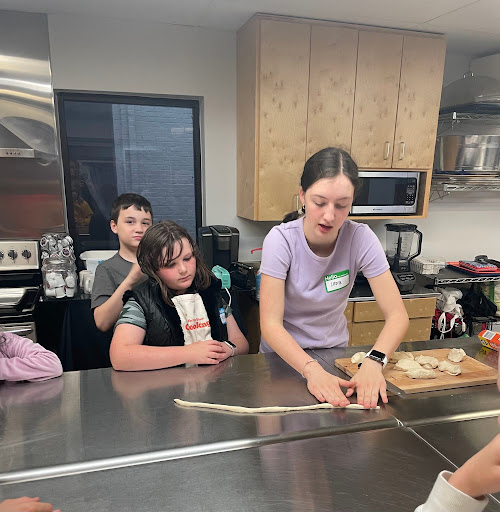A notification pings a student’s phone with a reminder to complete their daily lesson on the popular language learning app Duolingo. The student swipes it up, ignoring it. Another one comes an hour later, a steady reminder of your jeopardized streak.
Going onto TikTok as a break from the day, the student sees a dancing green bird interacting with Dua Lipa, compelling users to download the app.
Through its social media platforms, Duolingo entices downloads with promises of crossing international language barriers, but its gamification has U-High students questioning whether the app is helping them learn a language or if it’s really just a game.
Duolingo has used an easy, free marketing strategy to gain popularity: TikTok. By creating a quirky presence on social media for the app’s mascot, a green owl named Duo, Duolingo’s brand was created.
“I think Duolingo’s social media presence has endeared people to the platform, especially younger users,” Ana Grieve, a senior, said. “I also think that by making sillier content they have been able to remain relevant which has probably added to their user base.”
Even though there was a spike in downloads after the mascot became a familiar presence for many on TikTok, U-High students also have different reasons for using the app.
Junior Maya Pytel, who has a streak of 843 days — 27.7 months or 2.3 years — started using Duolingo in 2021 to connect with her grandparents more.
“I spoke Polish with them as a child but less as I was growing up, so I’ve kinda forgotten it a bit,” Maya said, “The reason I use Duolingo is so I can communicate with my grandparents better and get to know them and their personalities a bit better, which is an opportunity that I am very lucky to have.”
Jashan Gill, a junior, uses Duolingo for the same reason as Maya, to communicate with his family. But for Jashan, the gamification elements cause him to put his learning Hindi on the back burner and just focus on keeping his 572-day streak.
“With Duolingo, I think the issue sometimes is gamification,” Jashan said. “It certainly helps you with motivation and stuff, but then also what I’ve gotten to know is I’m just keeping up my streak and not learning so much. I’m not really learning anything. I’m just keeping it up.”
Ana speaks English, Spanish and Mandarin but started using Duo Lingo in May to learn Portuguese. She’s accumulated a streak of 119 days. Since she already had a foundation in Spanish, she thought learning Portuguese was a reachable goal.
“I kinda wanted to challenge myself to see if I could learn a language by myself,” Ana said. “Portuguese is really similar to Spanish, and it seems like it would be very easy to pick up ”
Ana enjoys the game-like aspects of Duolingo but finds that it isn’t effective for learning and doesn’t make up for the app’s lack of challenge.
“I think the streak aspect does help a lot because it’s so motivational,” Ana said. “I think the fact that it’s so, like, bright colors and fun shapes and stuff, like, that kinda game-like does help a lot with making me want to do it. But in some ways, because it’s not as challenging as it should be because they want you to keep coming back, it can be hard to get a real education experience out of that.”
Maya finds that learning from Duolingo provided her a good opportunity to understand the basics of Polish, but to effectively learn the language, practicing in actual conversation is a better tool.
“I think Duolingo has certain aspects that make it good. Like, learning vocabulary can be very useful,” Maya said. “But I think that grammar structures I don’t learn very effectively on Duolingo, and it’s more through conversation and error that I learn those things.”
Although Duolingo has been helpful in learning, Maya doesn’t find a need to continue the program. The thing calling her back to the app isn’t the new language she’s learning but the streak she wants to keep growing.
“If I lost my streak,” Maya said, “I would definitely not be doing Duolingo.”
This story was originally published on U-High Midway on November 10, 2023.






![It was definitely out of my comfort zone to get [the dress] and decide I loved it enough not to wait and risk not having something that memorable.](https://bestofsno.com/wp-content/uploads/2024/04/Precious_20180902_JRS_00008_ed1.jpg)


![Sophomore Sahasra Mandalapu practices bharatanatyam choreography in class. These new dances will be performed in an annual show in February. Mandalapu found that practicing in class helped her overcome stage fright during her performances. “When [I] get on stage, Im nervous Im going to forget, even though Ive done it for so long,” Mandalapu said. “Theres still that little bit of stage fright [when] I second-guess myself that I dont know it enough, but I do because Ive been practicing for a whole year.”](https://bestofsno.com/wp-content/uploads/2024/05/Sahasra-6-Large-1200x844.jpeg)

![In their full runway outfits, (from left) Audrey Lee 25, Olivia Lucy Teets, 25, Fashion Design teacher Ms. Judy Chance, and Xueying Lili Yang pose for a photo. All three girls made it to Austin Fashion Week by getting in the top 10 in a previous runway show held by Shop LC.
[I like my students] creativity and how they can look at a fabric and make it their own, Ms. Chance said.](https://bestofsno.com/wp-content/uploads/2024/04/IMG_9686-e1714088765730-1129x1200.jpeg)














![IN THE SPOTLIGHT: Junior Zalie Mann performs “I Love to Cry at Weddings,” an ensemble piece from the fall musical Sweet Charity, to prospective students during the Fine Arts Showcase on Wednesday, Nov. 8. The showcase is a compilation of performances and demonstrations from each fine arts strand offered at McCallum. This show is put on so that prospective students can see if they are interested in joining an academy or major.
Sweet Charity originally ran the weekends of Sept. 28 and Oct. 8, but made a comeback for the Fine Arts Showcase.
“[Being at the front in the spotlight] is my favorite part of the whole dance, so I was super happy to be on stage performing and smiling at the audience,” Mann said.
Mann performed in both the musical theatre performance and dance excerpt “Ethereal,” a contemporary piece choreographed by the new dance director Terrance Carson, in the showcase. With also being a dance ambassador, Mann got to talk about what MAC dance is, her experience and answer any questions the aspiring arts majors and their parents may have.
Caption by Maya Tackett.](https://bestofsno.com/wp-content/uploads/2024/02/53321803427_47cd17fe70_o-1-1200x800.jpg)
![SPREADING THE JOY: Sophomore Chim Becker poses with sophomores Cozbi Sims and Lou Davidson while manning a table at the Hispanic Heritage treat day during lunch of Sept 28. Becker is a part of the students of color alliance, who put together the activity to raise money for their club.
“It [the stand] was really fun because McCallum has a lot of latino kids,” Becker said. “And I think it was nice that I could share the stuff that I usually just have at home with people who have never tried it before.”
Becker recognizes the importance of celebrating Hispanic heritage at Mac.
“I think its important to celebrate,” Becker said. “Because our culture is awesome and super cool, and everybody should be able to learn about other cultures of the world.”
Caption by JoJo Barnard.](https://bestofsno.com/wp-content/uploads/2024/01/53221601352_4127a81c41_o-1200x675.jpg)





